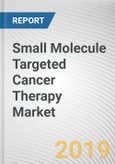Small Molecule Targeted Cancer Therapy has a targeted approach and minimal after side- effects; this results into increased rate of adoption of the therapy by the end users. This is the major factor that is driving the growth of the market. Moreover, increase in the rate of cancer incidences is also contributing to the growth of the market. The substantial hurdle for the growth of the market is the rate of the approved chemical drugs that is declining every year due to stringent regulations. In addition, low awareness among end-users and high operational cost are also hampering the growth of the market. Drugs that are losing their patents such as Norvartis’s Glivec are unlocking the door of opportunity for the manufacturers of the Small Molecule Targeted Cancer Therapy.
Small Molecule Targeted Cancer Therapy Type Market Analysis
Small Molecule Targeted Cancer Therapy type market is segmented into monoclonal antibodies, small molecules and small molecule drug conjugates. Monoclonal antibodies can be further segmented into fully human antibody (with an immune system target), chimeric monoclonal antibody (with a tumor target) and humanized monoclonal antibody (with a circulatory system target). Small Molecules can also be further segmented into small molecule cyclin-dependent kinase inhibitor, small molecule proteasome inhibitor and small molecule tyrosine kinase inhibitor. Small Molecules segment is the largest revenue generating segment due to its kinase inhibitor that can provide relatively more protection to the normal cells. It can efficiently destroy the selected target cells and prevent the growth of the tumor.
Small Molecule Targeted Cancer Therapy Geography Market Analysis
Geographically, Market is segmented into North America, Europe, Asia Pacific and RoW. North America is the largest revenue generating segment due to relative rise in the cancer cases.
Competitive Landscape
The key strategies adopted by the companies to expand in the Small Molecule Targeted Cancer Therapy market are product launches, mergers & acquisitions and agreements & collaborations. These strategies would provide efficient products and yield strong performing products that support the market regulations and finally, exhibit better customer satisfaction. The companies profiled in this report are OncoGenex Pharmaceuticals, Inc., Cytokinetics Inc., Hospira Inc., GlaxoSmithKline plc, Boehringer Ingelheim GmbH, Bayer HealthCare AG, and Abbott Laboratories.
High Level Analysis
The report analyzes various macro environments of the Small Molecule Targeted Cancer Therapy market using porter’s analysis. According to porter’s analysis, the bargaining power of the supplier is high due to high cost of switching. The bargaining power of buyer is low due to the specialized products of Small Molecule Targeted Cancer Therapy market and threat of substitute is low due to unavailability of alternate products.
Key Benefits
- The study helps to analyze the Small Molecule Targeted Cancer Therapy market trends to provide excess intelligence into the entire market segment and thus, helps the market players to make strategic decisions
- To study the various factors that are enhancing and restraining the development of the market that would help the stakeholders in understanding the market in detail
- To identify competitive strategies adopted by the top players due to certain government regulations and thus, assist the stakeholders in taking actionable decisions
- Porter’s five forces model helps to understand the scope of bargaining power of buyers and suppliers and threat of the new entrants
- The analysis focuses on the wide variety of opportunities for the growth and expansion of the market
Key Market Segment
Small Molecule Targeted Cancer Therapy market Analysis is segmented on the basis of Type and geographies.
Market by Type
Monoclonal Antibodies
- Fully Human Antibody
- Chimeric Monoclonal Antibody
- Humanized Monoclonal Antibody
Small Molecules
- Small Molecule Cyclin-dependent Kinase Inhibitor
- Small Molecule Proteasome Inhibitor
- Small Molecule Tyrosine Kinase Inhibitor
Small Molecule Drug Conjugates
Market by Geography
- North America
- Europe
- Asia Pacific
- RoW
Methodology
The analyst offers exhaustive research and analysis based on a wide variety of factual inputs, which largely include interviews with industry participants, reliable statistics, and regional intelligence. The in-house industry experts play an instrumental role in designing analytic tools and models, tailored to the requirements of a particular industry segment. The primary research efforts include reaching out participants through mail, tele-conversations, referrals, professional networks, and face-to-face interactions.
They are also in professional corporate relations with various companies that allow them greater flexibility for reaching out to industry participants and commentators for interviews and discussions.
They also refer to a broad array of industry sources for their secondary research, which typically include; however, not limited to:
- Company SEC filings, annual reports, company websites, broker & financial reports, and investor presentations for competitive scenario and shape of the industry
- Scientific and technical writings for product information and related preemptions
- Regional government and statistical databases for macro analysis
- Authentic news articles and other related releases for market evaluation
- Internal and external proprietary databases, key market indicators, and relevant press releases for market estimates and forecast
Furthermore, the accuracy of the data will be analyzed and validated by conducting additional primaries with various industry experts and KOLs. They also provide robust post-sales support to clients.

LOADING...








